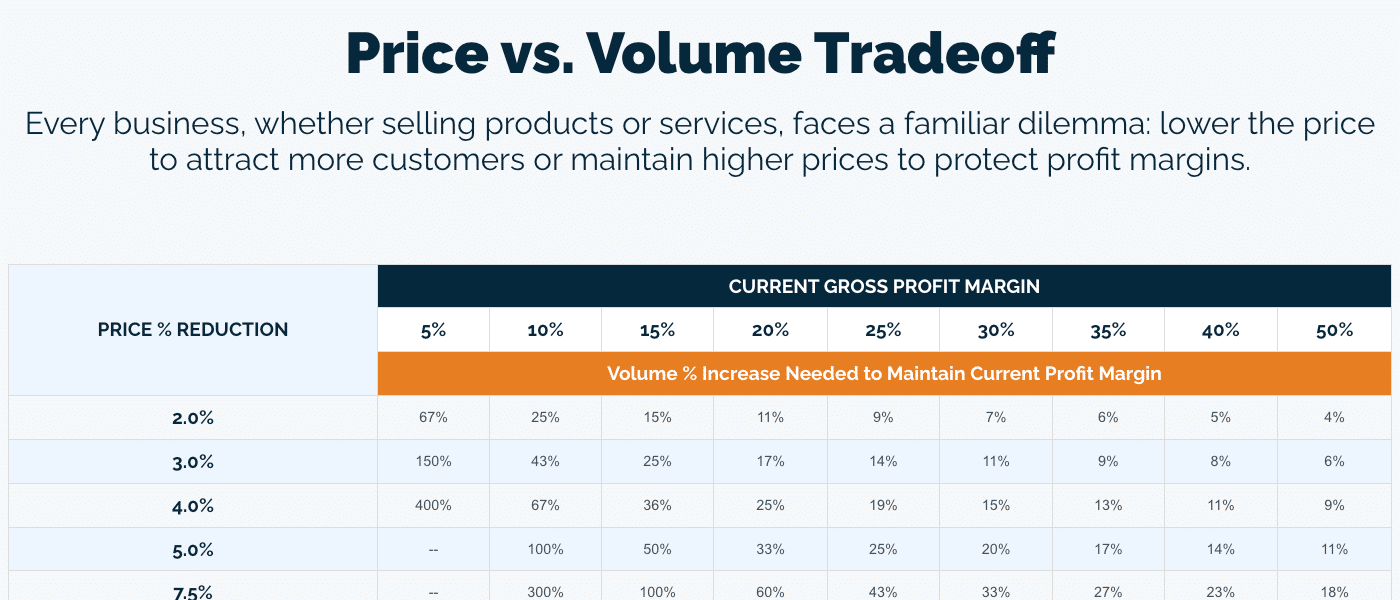How to Profitably Navigate Customer Price Concessions

Macro- and microeconomic conditions are constantly changing, and it’s crucial for businesses to keep their pricing solutions and strategies updated. In times of inflation, economic growth, and business innovation, differentiated price increases are one of the best pricing methods to increase profitability and growth. However, during disinflation and cost volatility, your pricing organization needs to respond swiftly and thoughtfully to external pressures.
Price concession requests from customers can happen at any time, but they are especially pronounced during economic uncertainty. While price concessions may be necessary at times, unnecessary concessions can compromise profits and stall growth.
What are Price Concessions?
A price concession is when a business accepts a lower price from a customer than the original stated or understood price. There are many reasons why this could occur, including:
- Changing market environments that create fear or hesitancy in sales teams to push back or negotiate on customer requests
- Lack of pricing guidance or guardrails for the sales team
- Lack of visible pricing analytics to understand historical pricing decisions and margin implications at the time of sale
- Lack of customer communication strategy across the sales organization
- Lack of price negotiation training and skills
- Sales goals that prioritize individual sales or volume without understanding the effects on price or margin
While price concessions are sometimes warranted, a concerted effort is required to understand when and why they are happening to avoid ongoing, unwarranted price concessions.
How to Avoid Unnecessary Price Concessions
There are two elements necessary to avoid unnecessary price concessions that should be equally understood and implemented for an optimal pricing solution:
- Embedding the logic behind managing price concessions within your pricing strategy and in the pricing model
- Recognizing and educating your sales team on the psychology of price concessions
The Logic Behind Managing Price Concessions
The logic behind profitably managing price concessions refers to the data, processes, and pricing programs that prevent unwarranted price concessions. This includes the pricing strategy you employ as well as the pricing model that encodes and distributes your pricing.
The first step to ensure your pricing strategy maximizes the value captured is to incorporate the following:
- Customer segmentation: Are similar customers based on value perceptions, size, region, tenure, purchase frequency, price sensitivity, etc. segmented together and receiving similar pricing?
- Cost to serve: Do price recommendations consider the full cost of customer service and other implied costs of working with a client?
- Cost changes: Do price recommendations incorporate actual or expected increases in COGS, such as raw materials or freight?
- Market nuances: Does the pricing model adapt to changes in market conditions, such as regional or industry-based price sensitivity, supply chain disruptions, or competitive changes?
- Value delivered: Does your model account for the total value you provide to your customers, including add-on services or special promotions?
Knowing your pricing model produces optimized price recommendations instills confidence in your salesforce and customers that pricing is fair, market-relevant, and reflects the value you deliver.
Once your pricing strategy is well-defined, it can be codified into a pricing model that optimizes the price recommendations and concessions based on customer-product combinations. This pricing infrastructure needs to provide clear policies and procedures on items such as:
- Price floors and ceilings: Your pricing model may provide an optimal price recommendation with a range of acceptable price points. This gives sales teams the flexibility to negotiate while maintaining margin goals.
- Approval processes: If a salesperson wants to price outside the pre-approved range, there should be clear and systematic processes to manage price overrides.
- Discount allowances: Similar to price floors and approval processes, an acceptable discount amount should be understood for each customer, and deviations may trigger an alert/approval process before sales may proceed.
Finally, communicating clear expectations and creating visible feedback loops through performance management creates a culture of price management. This includes:
- Centralized pricing analytics that methodically track items such as historical price points alongside override justifications, contract or other partnership terms, and historical price realization.
- Methods to hold the sales team accountable to the established infrastructure, such as transparent measurement by salesperson and systems of rewards such as commission.
The Psychology of Managing Price Concessions
Price concessions cannot be tackled with logic alone. While the development of pricing models and infrastructure is no easy task, preparing and mastering the psychology of price concessions is arguably even more daunting. The sales team needs to feel confident addressing price concessions during conversations with their customers. To achieve this level of preparedness, INSIGHT recommends:
- Sales training on your pricing strategy and policies: Your sales team should understand how your pricing model calculates price recommendations and be able to succinctly communicate the value delivered and the underlying price logic in a way that resonates with the customer.
- Visibility to your pricing analytics: Running monthly price measurement reports for the sales team is not enough. To make data-driven decisions instead of emotion-based reactions, your sales team needs to be armed with pricing analyses by customer—including historical purchase patterns, price variation, margin trends, potential areas of leakage, and more—before opening customer conversations.
- Price negotiation training: There are many necessary conversations that sales leaders dread having with their customers. However, the ability to handle a price concession hangs on how well your front-line reacts to real-time customer pushback. If-then scenarios and sales script training provide a baseline toolkit. Empowering your sales team with critical thinking skills and behavioral science allows them to navigate the most complex price negotiations with conviction.
- Messaging over long-term relationships: Accurately describing and documenting pricing rationale and supporting messaging is critical to long-term negotiations. From a customer’s perspective, if a previous price increase was only tied to cost changes, they may feel justified in asking about a price reduction if costs go down. Conversely, if a price increase was tied to delivering additional value or a higher service level, is the sales team measuring and demonstrating the additional benefit received to key stakeholders?
Overcoming anchoring bias: For clients that have received a “sweetheart” deal over multiple cycles, sales teams may need to stage price increases over time or cut unprofitable customers to free up capacity for margin-accretive business.
Managing Price Concessions for Short- and Long-Term Profitability
It’s challenging to avoid customer price concessions altogether. That’s why it’s essential to have a pricing solution and strategy that considers how your team will handle customer pushback, especially when profitability is on the line.
INSIGHT2PROFIT doesn’t deal in the theoretical, we create and implement pricing solutions that generate real impact. If you would like to talk through either the logic or the psychology of your team’s price concession challenges, contact us to find out how INSIGHT’s experts are prepared to tailor a solution to fit your unique situation.


